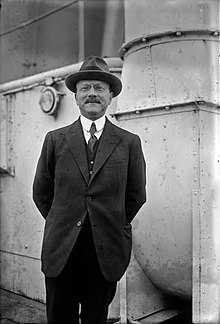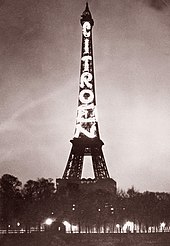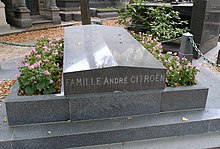André Citroën
André Gustave Citroën [ sitʀoˈɛn ] (born February 5, 1878 in Paris , † July 3, 1935 ibid) was a French automobile designer .
Life
André-Gustave Citroën was the fifth child of Masza Amalia Kleinmann ( Warsaw ), who came from Poland, and Levie Citroën, a Belgian Jewish jeweler from Amsterdam . His ancestors had established themselves as a fruit dealer in what was then Holland, which is why they adopted the family name Lemonenman , which later became the Francophone Citroën . Although his father had built a solid existence as a jeweler in Paris, he committed suicide when André was six years old after severe mood swings and bad business luck.
André graduated from primary school with top grades and then attended the École polytechnique , one of the Grandes écoles , the elite schools in France. He loved Jules Verne in his school days . After completing his training, he joined the army as a technical officer. During a trip to relatives in Poland in 1900, he saw unfamiliar gears on various occasions , one of which he patented on his return to Paris. It was the double-angle form of a gear wheel tooth, which became the model for the company logo of the car brand Citroën .
In 1905, together with three partners, he founded a company to manufacture gearboxes. From 1908 he worked for the automobile manufacturer Mors , where he was able to increase production from 10 to 100 cars per month within five years. In 1912 he visited Henry Ford and studied the production methods in his automobile factory. The following year he returned to his own company from Mors .
Marriage and war
On May 27, 1914, a few months before the outbreak of World War I , he married Giorgina Bingen, the daughter of a Genoese banker. In the same year he was called up for military service and came to the front. He experienced the fatal ammunition shortage after the Battle of the Marne (1914) , whereupon Citroën made the artillery director an offer to increase the production of cannon ammunition . Within a short time he increased production tenfold. His brother Bernard died in the war.
Automobile production
In 1919 the Citroën Type A (also Citroën 10HP ), his first mass-produced automobile, was produced.
Towards the end of the war he had to fill his ammunition factory with a new product and so he began to manufacture cars in Javel . His first customer was a man named Testemolle who bought a Citroën Type A for 7950 francs in 1919. This automobile had a 4-cylinder engine with a capacity of 1327 cm³ and an output of 18 hp and - as a great advantage over all competitors - an electric starter .
From 1920 Citroën produced half-track vehicles . The engineer Adolphe Kégresse invented this caterpillar drive .
Croisière Noire
During a test drive, André Citroën immediately recognized the advantages of this drive and the great advertising effect for his own brand. In 1922 an expedition crossed the Sahara from Touggourt to Timbuktu for the first time using five half-track vehicles . Citroën started the expeditions Croisière Noire (1924–1925 across Africa from Colomb-Béchar to Antananarivo ), then the Croisière Jaune (1931–32 crossing of the Himalayan Mountains, starting points were Beirut and Beijing ), Croisière Blanche (1934, Alaska , at Temperatures between −70 and −20 degrees Celsius).
The businessman
Between 1925 and 1936, Citroën used the Eiffel Tower as an advertising medium by having his name affixed in illuminated letters, which Charles Lindbergh used for orientation when he arrived in Paris in 1927 after crossing the Atlantic. Citroën capitalized on Lindbergh's success by inviting him to his plant and celebrating the Atlantic crossing with his employees.
In 1934, Citroën launched the first front-wheel drive automobile , the Traction Avant (his comment on the series introduction: “A horse doesn't push a car, it pulls it”). The high development costs of this vehicle led to the ruin of the company. Citroën went broke and in 1935 sold its company to Michelin , the largest creditor. To this end, the Board of Directors signed a Michelin-Citroën agreement as early as 1934 .
The two fathers of the Traction Avant, the designer Flaminio Bertoni and the constructor André Lefèbvre , continued to work successfully on new developments.
death
André Citroën died on July 3, 1935 of a malignant tumor. He found his final resting place on the Parisian Cimetière Montparnasse .
Others
Citroën was a member of the Masonic Lodge La Philosophie Positive in Paris. The British philosopher AJ Ayer is the son of his niece Reine Citroën.
literature
- Jacques Wolgensinger: André Citroën . Biography. Motorbuch, Stuttgart 1996, ISBN 3-613-01504-8 (French: André Citroën . Translated by Klaus Troller, Dagmar Troller).
Web links
- Axel Polanschütz u. a .: The development of the automobile company Citroën from its beginnings to 1939
- André Citroën - The person behind the brand. About an exhibition in the Jewish Museum in Rendsburg
- Wilfried Pleiter: André-Gustave Citroën on his website http://www.doublechevron.de/ (“Citroën, the brand with that certain something”), accessed on July 3, 2010
- Deutschlandfunk, www.dradio.de: Broadcast calendar sheet from June 3, 2010, Mathias Schulenburg: Der Herr der Ente
- Newspaper article about André Citroën in the 20th century press kit of the ZBW - Leibniz Information Center for Economics .
| personal data | |
|---|---|
| SURNAME | Citroën, André |
| ALTERNATIVE NAMES | Citroën, André Gustave (full name) |
| BRIEF DESCRIPTION | French automobile designer |
| DATE OF BIRTH | February 5, 1878 |
| PLACE OF BIRTH | Paris |
| DATE OF DEATH | July 3, 1935 |
| Place of death | Paris |



